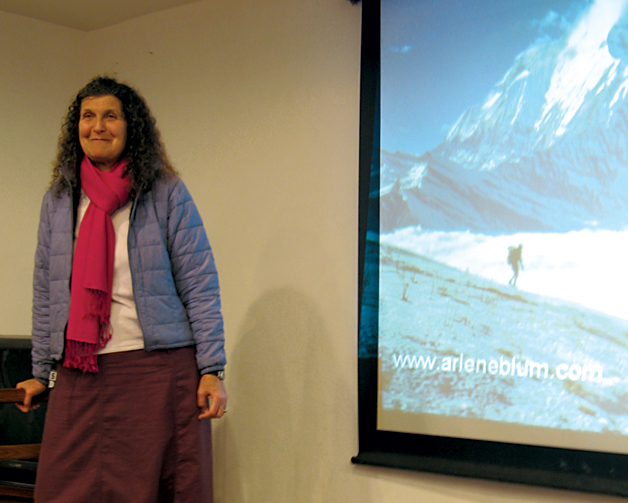
The room in the Summit Hotel where Arlene Blum waited to talk was full of expatriates, not unusual for a Cultural Studies Group talk—but on the side, sitting on the edge with nervousness and excitement, was a group of very young Nepaliwomen. After her talk, I went up to them and discovered that they were an all female team about to attempt Mt Everest. The glow they had in their eyes reflected the boost of energy we had received from an inspirational woman.
“Look at this slope. Isn’t this an easy one? Wouldn’t you just love to be up there?” she asks the audience, pointing to a slide with a gentle slope. And yes, after listening to Arlene, we can almost imagine ourselves halfway up a high
altitude mountain slope. Tall and grey-haired, Arlene is distinguished and yet still full of childlike enthusiasm for her two passions—mountaineering and chemistry.
A chemist who got her PhD during the Seventies, when the academic
establishment was still hostile to the idea of women entering scientific fields, Arlene managed, on the side, to lead the first all women’s team to Denali, North America’s tallest summit. She was also the first to lead an all female team to the summit of Annapurna, and the first American woman to attempt Everest.
What takes a young girl from a sheltered Jewish family in Chicago and launches her full force out into the adventurous and dangerous world of mountain climbing? For Arlene, it seemed to have been a combination of love for a man and the discrimination she faced as a woman.
In her book, Breaking Trail, Arlene describes John Hall, an early mountain climbing companion who took her on his climbs and for whom she had a deep attachment. John is so handsome Arlene is sweating by the time she gets out in the parking lot on her first trip. Her first attempt at climbing, which she describes with a great deal of humor and grisly detail (the back of her pants is rubbed off from sliding down sand and gravel; and she has to take an inflatable toilet seat to sit on during class) only convinces her that she loves climbing. John eventually dies, buried in an avalanche, just as he is about to join Arlene on an ‘Endless Winter’ expedition. Arlene describes the moment in which she thinks he has come back and is sitting in her porch. She searches for him, and is told that he’s not yet arrived. A few days later, she reads the newspaper and finds out he was buried under an avalanche—on the same day that she thought she saw him sitting on her porch.
Her book resonates with examples in which she faced discrimination as a woman in the male dominated worlds of chemistry and mountain climbing. She is told time and again that women cannot climb. In one instance, a male climber won’t shake her hand because she’s a woman. Men are afraid that women will have their periods and start getting hormonal and emotional on the high slopes. Her awareness of discrimination is acute, and at times overwhelms the reader.
The title ‘Breaking Trail’ comes from her own self-analysis about whether she held her own in the high mountains. Had she just piggybacked off the male members of her expeditions, or had she held her own weight? Through self-reflection, she concludes that her contribution to her teams came through her ability to break new trail. When team members are reluctant to try a new path, they send Arlene ahead. Although not the strongest of the team, she is always willing to forge ahead into new territory.
Just as she struggles to fit in as a woman in male-dominated environments, Arlene also struggles to fit in as a modern young American amongst a traditional Jewish family. Her mother has made a mistake and married the wrong man. Arlene never quite learns who her father is, or what he did wrong. Her happiest moments, then, are escaping ostracization by her family and walking around in the Chicago snow by herself—a childhood habit which served her well in the cold and lonely mountain slopes in adulthood.
In MIT, she describes the blatant intolerance of her professors when she joins the Chemistry Department. Unable to stand the East Coast, Arlene transfers to Stanford where she eventually gets her PhD. In the heady anti-war, feminist and civil rights movements of the West Coast, she conducts research free of the constraints she faced in MIT. She analyzes a fabric from which children’s clothing is made—the substance in the clothing, it turns out, causes cancer. She writes an article in Science magazine and gets that chemical banned. Many years later, she finds out that the same substance, under a different name, is being marketed as a fire retardant for upholstery.
The chemical industry has made it mandatory for the chemical to be applied to all furniture on the West Coast. That Californian love of the environment, and the harmful effects of chemicals, is palpable as Arlene Blum diverts from her talk about mountains and plunges into a dense but fascinating talk about chemicals and how they can affect people’s health. The activist in her emerges as she informs us that the chemical industry is now trying to make the same harmful fire retardant a mandatory application on computer printers—an unnecessary application. And no, this woman is not just a theoretical scientist—it is apparent that she will be out there, breaking trail, making sure that this harmful chemical do not get coated onto household items and passed into our homes.
What impressed me about Arlene Blum was not just her clear-eyed vision of the mountains, which she obviously loved, but also her activism for a cleaner, more accountable world. Her activism, like her mountaineering, has broken new ground in encouraging policies that improve people’s lives. This is one woman who circled the world and saw some of the most spectacular scenes from the world’s tallest mountains and glaciers. Like other mountaineers, she’s a witness to the massive melting of glaciers that has happened in the last few decades with the exponential warming of the planet.
Never doubt that a few committed citizens can change the world, said some wise philosopher. Looking at Arlene Blum, it was clear that we were in the presence of greatness—and yet she spoke with the childlike lilt and cadence of a child. In a talk I heard in New York, I noticed a similar note in Arundhati Roy’s voice. Perhaps extraordinary women with extraordinary power must always disguise themselves in order to speak truth to power. Along with her voice, Arlene appeared to have a child’s clear-eyed sense of injustice, possibility and hope. There is no doubt that if anybody can reverse and change the destruction occurring in this planet, it will be by extraordinary individuals from ordinary backgrounds, not unlike Arlene Blum.
Sushma Joshi is a writer and filmmaker. She can be contacted at sushma@alumni.brown.edu. For more about Arlene Blum, see www.arleneblum.com.










